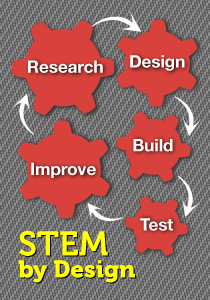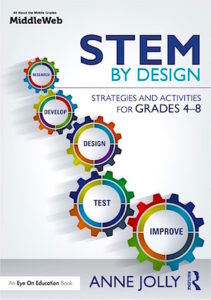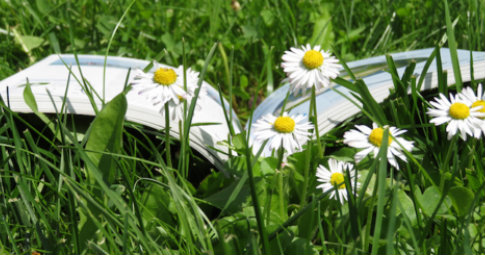A Summer’s Worth of STEM PD/Prep Ideas!
A MiddleWeb Blog
 School is out or soon will be for summer – a time when most teachers can kick back and take full advantage of a sun-and-fun break.
School is out or soon will be for summer – a time when most teachers can kick back and take full advantage of a sun-and-fun break.
No more thinking about students and school, right? Wrong! (You knew that. Teachers are always learning.)
In my years teaching middle school science, summer was an ideal time to pause, take a deep breath or two, and let my mind wander over lessons and learning that took place during the previous school year. Inevitably, ideas for changes and improvements drifted to the surface as I thought about things that went great and . . . well, not so great.
Since STEM is a fast-growing program concept, new ideas and resources are rapidly emerging. Using some summer hours to locate and think through new ways to ratchet up your STEM success is a smart move.
And if you’re a new STEM teacher, or starting a new STEM program, this is a perfect time to dive in and wrap your head around what you can do to get off to a great start when school begins this fall.
I’ve gathered together a 2019 Summer Break Collection of resources and suggestions designed to spark some fresh ideas and may help you add pizazz to your STEM lesson plans with “2020 foresight.”
Focus on your own learning first
What you know matters. Start by homing in on what you need to understand most to build stronger content and STEM skills in your classes and to boost your students’ engagement and learning. List your ideas as they emerge. For example, you may be wondering about how you can . . .
- Help kids understand and apply key concepts in science and math at deeper levels. Check out TED Talks. Search for topics you want to know more about for content objectives you will include in STEM lessons.
- Blend digital technology into your STEM classes in a more authentic way. This post by Curtis Chandler contains great ideas for technology your kids can use to learn and create all year. I enjoyed every link!
- Use maker spaces to help kids explore ideas, create, and invent. Lots of info is out there on this initiative, and this site is a good place to start.
- Keep kids thinking creatively and inventively. They most often do this when they are working on something they are passionate about. For example, look at why these teens were so focused on inventing.
- Design your STEM lessons to tap into students’ passions. Edutopia has some suggestions here. Also, carefully consider the engineering problems for which your kids might search for solutions. My post STEM Problems Students Can Really Address and Getting Smart’s Real-World Projects may help you.
Maybe productive student teamwork is something you want to know more about. (If that’s the case, check out the free Student Teaching Tips Handbook. As a FYI, there are a lot of tools and resources on the site, and they are all free for you to use.)
Remember – you don’t have to tackle everything on your list at once. Just choose one thing and get started.
Build up a toolkit of STEM information and resources
Spend some time this summer exploring STEM online resources. This undertaking will keep STEM on your front burner, build your enthusiasm, and generate new ideas for your classroom.
You likely know how to access and browse a wealth of online information. If you haven’t set up a site for locating STEM articles and stashing the “keepers,” I highly recommend doing so. One tool I used is Scoop.it. You can view some of the articles I saved here. (This tool is less useful for me now that the free content curation is limited but still worth considering. If you have another app idea for this purpose, share in the comments!)
I also use Google Alerts to locate articles on STEM lessons and STEM education. Anybody use Pinterest to save the important information you come across? Diigo? I use both. Sometimes I simply drag links of articles I want to keep into a desktop folder.
Another way to stay abreast of the latest articles, blogs, and activities that involve STEM is by subscribing to some SmartBriefs – free, attractive, news summaries. Warning: you may have to scroll down a list of other worthwhile education articles to find those dealing with STEM, but that’s interesting, too.
I subscribe to the free newsletters MiddleWeb SmartBrief, STEM Smartbrief, ASCD SmartBrief, SmartBrief on EdTech, and Accomplished Teacher SmartBrief (NBCT), and my list is growing. It takes me about 30 seconds to browse and locate any material I want to read. I also recommend the websites Edutopia and MindShift for spotting good, informative reads on STEM-related subjects. You can follow them on Twitter too: @Edutopia and @MindShiftKQED.
Establish a personal learning network
Summer is also a great time to put together a learning and support network for teaching STEM. You likely already have an online network composed of friends on a number of social media platforms. You may have even intentionally networked with colleagues to explore and discuss STEM resources. If that’s the case, you have already established a personal learning network (PLN) – a community of friends and followers who share your STEM interests. This is a powerful STEM professional learning and support tool.
Many teachers and school leaders rely on Twitter’s hashtag communities to help build their online personal learning networks. You can easily follow hashtag communities in your Twitter aggregator (like TweetDeck) to spot lots of helpful STEM information. Try #STEM, #STEMchat, #stemed, #stemeducation, #nsta, #scienceed, #NGSSchat, #scichat, #makered and #edtech. Also check out the hashtags that these tweets contain. I follow @TeachingSTEM, @STEMAhead, and of course, @MiddleWeb! (Wonder about a hashtag? Explore the Hashtagify tool.)
Reach out to school colleagues
As you plan your PLN activities, keep in mind the value and importance of face-to-face interaction with fellow teachers. Hopefully you have a school-based professional learning team focused on STEM work. If not, consider inviting three or four colleagues to join you in meeting regularly to plan and do this work.

Plan for new and improved STEM lessons
As your mind drifts through the experiences and events of teaching STEM, you might start revamping last year’s lessons or generating ideas for new ones. To see if you’re on track with your lesson preparation, check out the EdWeek post Six Characteristics of a Great STEM Lesson. If you want to tweak your lessons to meet these criteria, this is a good time to make adjustments. STEM Lesson Specifications provides a checklist for adjusting and/or selecting real STEM lessons.
At the STEM by Design website you’ll find book excerpts, teaching tools, and more resources to help you plan good STEM lessons. You are welcome to download and use any of these you wish. And as you scroll through this MiddleWeb blog, you’ll find STEM topics that can help you with most any question you have on the topic. If I’ve missed something, please let me know!
As you plan your lessons, think of summer as a good time to gather some of those inexpensive lesson materials you know you’ll need and to locate sources for materials you’ll order after school starts.
In the event that you’re thinking of simply chilling out during July, please do that as well! But consider . . . a few STEM minutes at summer’s peak might make a big difference for you and your students when the leaves turn bright fall colors and the ghosts and goblins reappear!
___________________________________________






































